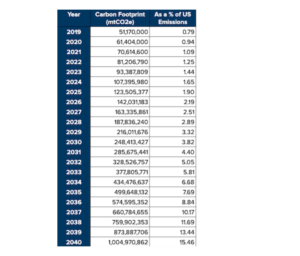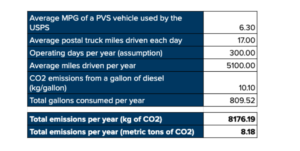E-Commerce Has a Climate Problem
By
Andrew Pickens
| 7 Oct 2020
By Andrew Pickens | 7 Oct 2020
There are about 165 billion packages shipped in the United States every year. That’s 503 for every person in the country.
With a few scrolls and clicks, an order is placed, and a fulfillment process is triggered. The product is zipped through a storage space on a conveyor belt, before being packaged and sorted for delivery. The consistency, speed, and flexibility of e-commerce deliveries have changed consumers’ expectations. And this new standard in retail is having a progressively damaging impact on the environment and human health.
The Stay-at-Home Economy’s Climate Costs
Global retail e-commerce sales, including products and services, are estimated to reach $6.5 trillion by 2023. In 2019, U.S. sales reached upwards of $600 billion. This was the largest share to date, fueled primarily by the world’s largest retailer, Amazon, which accounts for nearly 50% of market share.
In 2019, Amazon emitted 51 million metric tons of carbon dioxide equivalent (CO2-eq). Its carbon footprint increased 15% from the previous year thanks to a growth in sales. Those emissions represent about 0.7% of the 6.5 billion metric tons of U.S. CO2 emissions per year. We can expect the surge of e-commerce deliveries at Amazon to sustain a year-over-year increase, enabled largely in part by a growing stay-at-home economy from the coronavirus pandemic.
To illustrate the risk of Amazon’s growing CO2 emissions, as an outsized member of the burgeoning e-commerce industry, let’s suppose the 15% increase in its carbon footprint from 2018 to 2019 continues every subsequent year (see Figure 1). By 2021, the company would represent about 1% of total U.S. emissions, having doubled its carbon footprint from 2019 in only two years. Twenty years later, with a whopping 1 Gt of CO2e, Amazon’s emissions would represent more than those of Germany, twice that of the United Kingdom, and a little less than Japan’s in 2016.

To note: 2020 has an adjusted growth of 20% with assumption the stay-at-home economy will boom this year due to COVID-19 and grow Amazon’s distribution. We know a 15% growth in CO2e emissions for each year is unrealistic, and a peak, plateau, and a decrease should eventually materialize. Amazon has put forward pledges to reduce its emissions and become carbon neutral by 2040. These quick calculations also do not consider the purchase of offsets and the company’s recent headway in deploying electric delivery vans. Nor does it adjust for a change in U.S. emissions. It is depicting the worst-case scenario, with few assumptions made. It is, above all, hypothetical.
The Effects of a Single Delivery Van
The advent of e-commerce is contributing to the growing use of delivery vans. That growth has meant additional miles traveled by gas or diesel-powered vehicles. For each gallon of fuel consumed, 10 kilograms (about 22 pounds) of heat-trapping CO2 is released into the atmosphere. Let’s have a look at what that means for a delivery truck traveling about 300 miles a year to fulfill next-day toilet paper or shampoo orders:

A U.S. Postal Service (USPS) delivery van, with an internal combustion engine (ICE), travels an average of 6.3 miles per gallon of diesel. Over an assumed 300 days of operation, the van will travel an average of 5,100 miles. The total number of gallons consumed for that year will therefore be 810. That amounts to 8 metric tons of CO2 per year for a single delivery van (see Figure 2).
A program to replace USPS trucks with hybrids or electric trucks was launched in 2015, but has dragged on. This year, efforts to replace traditional trucks hit a speed bump due to a recent funding shortfall. If they can kick-start the program, switching out the ICE delivery vans with vehicles operating exclusively on electricity (e.g., EV) will not emit any tailpipe emissions. Amazon, on the other hand, is building its own delivery infrastructure with the aim to have an electrified fleet of 100,000 delivery vans on the road by 2024.
Released After Burning
In the U.S., major delivery carriers for e-commerce orders include FedEx, USPS, UPS, and DHL. To fulfill growing demand, each carrier has invested in differentiating their delivery options so customers can pay for better service and faster shipping. The business models of these actors are, by default, enablers of increasing CO2 emissions from the e-commerce industry.
In 2018, UPS, one of the largest shipping and logistics companies in the world, produced over 36 million tons of CO2e emissions. That’s a 7.5% increase from the year before, with the majority being Scope 3 emissions — those indirect, or “embedded”, emissions in services that represent the full supply chain.
That’s the equivalent CO2 emissions of nearly 10 coal-fired power plants running for a year, or close to the GHG emissions from 8 million passenger vehicles driven in a year. For UPS, Scope 3 emissions represent fuel used outside the boundaries established in Scope 1 or 2, and upstream transportation and distribution, the likes of packages handed off to third-party aircraft and trains.
Scope 3 emissions were, more often than not, ignored when reporting, even though these emissions represent about 40% of a company’s overall emissions. Only direct energy emissions are commonly accounted for in public reporting. Upstream and downstream emissions, direct and indirect emissions, are now becoming the standard. Of the nearly 1,000 companies that have set or have committed to setting a science-based target — an emission reduction target in-line with what leading scientists say is necessary for keeping global temperatures below 2 degrees Celsius — about 90% have set Scope 3 reduction targets. To inform policy, our understanding of the global carbon cycle, and ensure transparency, e-commerce companies must monitor and report their system-wide GHG emissions.
The difficulty of measuring emissions from last-mile delivery and packaging has posed problems for carbon accountants. Yet these two parts of the supply chain represent some of the largest shares of total CO2 emissions in the e-commerce industry.
Packaging produces enormous amounts of waste that build up in landfills, leading to increasing methane emissions that have 80 times the heat-trapping potential than CO2. However, the most pressing issue of the e-commerce supply chain is freight. Transportation emissions, namely freight, is the fastest-growing source of GHG emissions.
While worrying about the cost of a growing number of flights, trucking, and local vans for our speedy deliveries, we can’t ignore the effects of worsening air pollution on public health.
E-Commerce Bodes Ill for Public Health
Most short-haul deliveries referred to as “last-mile” (i.e., a product’s move from a warehouse to its utlimate destination) are made by medium and heavy-duty vehicles. These vehicles are typically diesel-fueled, internal combustion engines known to impact local air pollution and contribute to GHG emissions. Diesel vans release Particulate Matter 2.5 (PM2.5), Nitrous Oxide (NOx), Carbon Monoxide (CO), Volatile Organic Compounds (VOC), and Ozone (O3), which can cause severe respiratory problems and cardiovascular complications.
Local air pollutants from increased traffic are drivers of worsening asthma, shortness of breath, stroke, lung cancer, and cardiovascular disease. And their burden is not shared equally. Predominantly nonwhite communities, especially blacks, face a higher risk from particle pollution.
With speedier distribution, there come more freight and last-mile deliveries, because logistics companies can’t optimize routes as fast as needed. The result is fewer combined trips and a greater number of dedicated trips, which force more trucks onto the road at once.
Nearly 90% of the U.S. population will live in urban areas by mid-century. Rapid urbanization and a fast-growing e-commerce industry that puts additional polluting trucks on the street will spell increased acute air pollution and traffic congestion. Several recent scientific studies have pointed to poor air quality’s correlation to a higher COVID-19 mortality rate. An increase is associated with an 8% to 21% bump in death rates in the U.S. and the Netherlands.
The global pandemic’s halting of economic activity is bringing down carbon emissions. But history has proven that this kind of drop is temporary. The financial crisis of 2008 saw a similar dip in emissions. The recovery propelled levels back to normal with incremental growth since.
The rise of the e-commerce industry is a by-product of the pandemic which is undermining environmental gains. COVID-19 has shifted the societal and economic order toward a dependence on online services. Reigning in its environmental detriments will depend on scaled shifts to low-carbon technology and efficiency.
Attenuating the New Bazaar
The road to low and zero-carbon delivery is paved by smarter logistics and electrification. It’s a necessity for tackling climate change since transport is responsible for 14% of the planet’s GHG emission sources.
By doubling the average number of parcels purchased per customer and avoiding split shipments, retailers like Walmart, Amazon, and Etsy can reduce their average per-item emissions by 30%, according to Bain & Co.
Packaging and shipping parcels together avoid 35% higher emissions than when shipping them separately. The reduction comes from better fuel efficiency: fewer miles driven by polluting vehicles cuts emissions and local air pollution levels. Optimizing routes and consolidating loads will improve the fuel efficiency of delivery vans by shortening their driving range.
The second prong to arresting the emissions from the e-commerce industry is electrification. Displacing current internal combustion engines with cost-effective electric vehicles (EV) is vital to decarbonizing freight. Most short-haul deliveries (i.e., “last-mile”) are made by medium and heavy-duty vehicles. They are known to impact local air pollution and contribute to GHG emissions.
Developing financing solutions for third-party delivery channels (e.g., UPS, FedEx, etc.) to expand the industry’s EV use is underpins the second prong. Deployment of these “zero-emission” vehicles requires upfront capital that weighs against potential long-term cost savings, and the lack of available EV infrastructure does not bode well with the willingness to purchase EV delivery fleets.
Utilities will have to adapt to having to provide additional power for charging fleets, and shift to clean energy production for vehicles to be “zero-emission”. By doing so they can gain a competitive advantage. Wide-scale EV deployment aligns with a stream of local and state-level climate policies that are forcing e-commerce businesses into adopting low-carbon technologies. Policy incentives and proactive action by businesses can help them meet their tricky Scope 3 emissions reduction goals, since most of those emissions are found in third-party distributors (e.g., UPS deliveries, made on behalf of Etsy, are indirect Scope 3 emissions).
California recently adopted a rule requiring that half of all medium and heavy-duty trucks sold in the state be zero-emission vehicles by 2045 “where feasible”. There is no prescribing of specific technologies, just as long as they are zero-emissions, allowing for deployment of a variety of already-available vehicles. Luckily, California is already advancing “zero-emission” solutions to transport sector.
The “Advanced Clean Trucks” rule requires truck manufacturers to sell an increasing share of electric trucks each year. It’s a credit market that has manufacturers sell a percentage of zero-emission vehicles to earn credits that can be sold to those manufacturers not selling enough.
A variety of other incentives are available to tackle air and climate pollution from diesel trucks. Cities and states can institute tax credits, rebates, and financial assistance to improve the adoption of EVs and the build-out of charging infrastructure. And carriers like UPS and the U.S. Postal Service can do their part by improving logistics for last-mile delivery. By accounting for congestion peaks and reducing delivery times, medium-and-heavy-duty trucks can capture vast potential emission savings.
Zero Emissions Delivery (Please)
The U.S. share of e-commerce in total retail sales is growing in a sector of the economy expected to grow at a faster rate than that from any other sector. Improving the e-commerce supply chain, with a focus on last-mile delivery and packaging will encourage a shift in the ecosystem towards ubiquitous low-carbon delivery. That shift is crucial to keeping global temperatures to well below 2 degrees Celsius, toward 1.5 degrees Celsius, and avoiding vast economic, ecological, and human disruption from runaway climate change.
The coronavirus pandemic is speeding up a dangerous trend in the growth of e-commerce. A smart recovery can identify systemic changes that ensure most of the relevant players in the e-commerce ecosystem leverage their scale for the good of the planet. Doing so can help them meet customers’ expectations in this “new normal”.
This article first appeared in The Global Current
Andrew Pickens tweets @pickensa
Disclaimer: Views expressed in the blog are the author's own
